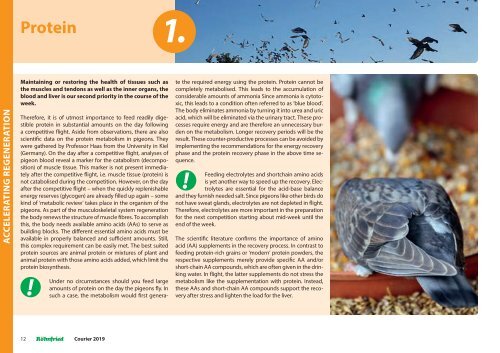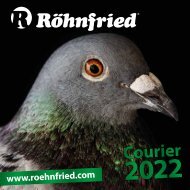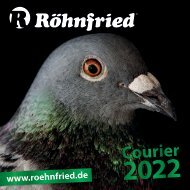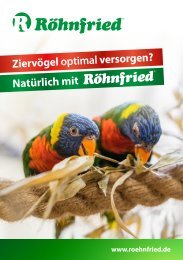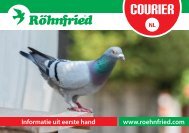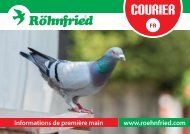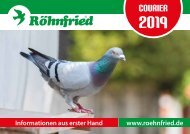Röhnfried Courier 2019 English
You also want an ePaper? Increase the reach of your titles
YUMPU automatically turns print PDFs into web optimized ePapers that Google loves.
Protein<br />
1.<br />
ACCELERATING REGENERATION<br />
Maintaining or restoring the health of tissues such as<br />
the muscles and tendons as well as the inner organs, the<br />
blood and liver is our second priority in the course of the<br />
week.<br />
Therefore, it is of utmost importance to feed readily digestible<br />
protein in substantial amounts on the day following<br />
a competitive flight. Aside from observations, there are also<br />
scientific data on the protein metabolism in pigeons. They<br />
were gathered by Professor Haas from the University in Kiel<br />
(Germany). On the day after a competitive flight, analyses of<br />
pigeon blood reveal a marker for the catabolism (decomposition)<br />
of muscle tissue. This marker is not present immediately<br />
after the competitive flight, i.e. muscle tissue (protein) is<br />
not catabolised during the competition. However, on the day<br />
after the competitive flight – when the quickly replenishable<br />
energy reserves (glycogen) are already filled up again – some<br />
kind of ‘metabolic review’ takes place in the organism of the<br />
pigeons. As part of the musculoskeletal system regeneration<br />
the body renews the structure of muscle fibres. To accomplish<br />
this, the body needs available amino acids (AAs) to serve as<br />
building blocks. The different essential amino acids must be<br />
available in properly balanced and sufficient amounts. Still,<br />
this complex requirement can be easily met. The best suited<br />
protein sources are animal protein or mixtures of plant and<br />
animal protein with those amino acids added, which limit the<br />
protein biosynthesis.<br />
!<br />
Under no circumstances should you feed large<br />
amounts of protein on the day the pigeons fly. In<br />
such a case, the metabolism would first generate<br />
the required energy using the protein. Protein cannot be<br />
completely metabolised. This leads to the accumulation of<br />
considerable amounts of ammonia Since ammonia is cytotoxic,<br />
this leads to a condition often referred to as ‘blue blood’.<br />
The body eliminates ammonia by turning it into urea and uric<br />
acid, which will be eliminated via the urinary tract. These processes<br />
require energy and are therefore an unnecessary burden<br />
on the metabolism. Longer recovery periods will be the<br />
result. These counter-productive processes can be avoided by<br />
implementing the recommendations for the energy recovery<br />
phase and the protein recovery phase in the above time sequence.<br />
!<br />
Feeding electrolytes and shortchain amino acids<br />
is yet another way to speed up the recovery. Electrolytes<br />
are essential for the acid-base balance<br />
and they furnish needed salt. Since pigeons like other birds do<br />
not have sweat glands, electrolytes are not depleted in flight.<br />
Therefore, electrolytes are more important in the preparation<br />
for the next competition starting about mid-week until the<br />
end of the week.<br />
The scientific literature confirms the importance of amino<br />
acid (AA) supplements in the recovery process. In contrast to<br />
feeding protein-rich grains or ‘modern’ protein powders, the<br />
respective supplements merely provide specific AA and/or<br />
short-chain AA compounds, which are often given in the drinking<br />
water. In flight, the latter supplements do not stress the<br />
metabolism like the supplementation with protein. Instead,<br />
these AAs and short-chain AA compounds support the recovery<br />
after stress and lighten the load for the liver.<br />
12 <strong>Courier</strong> <strong>2019</strong>


